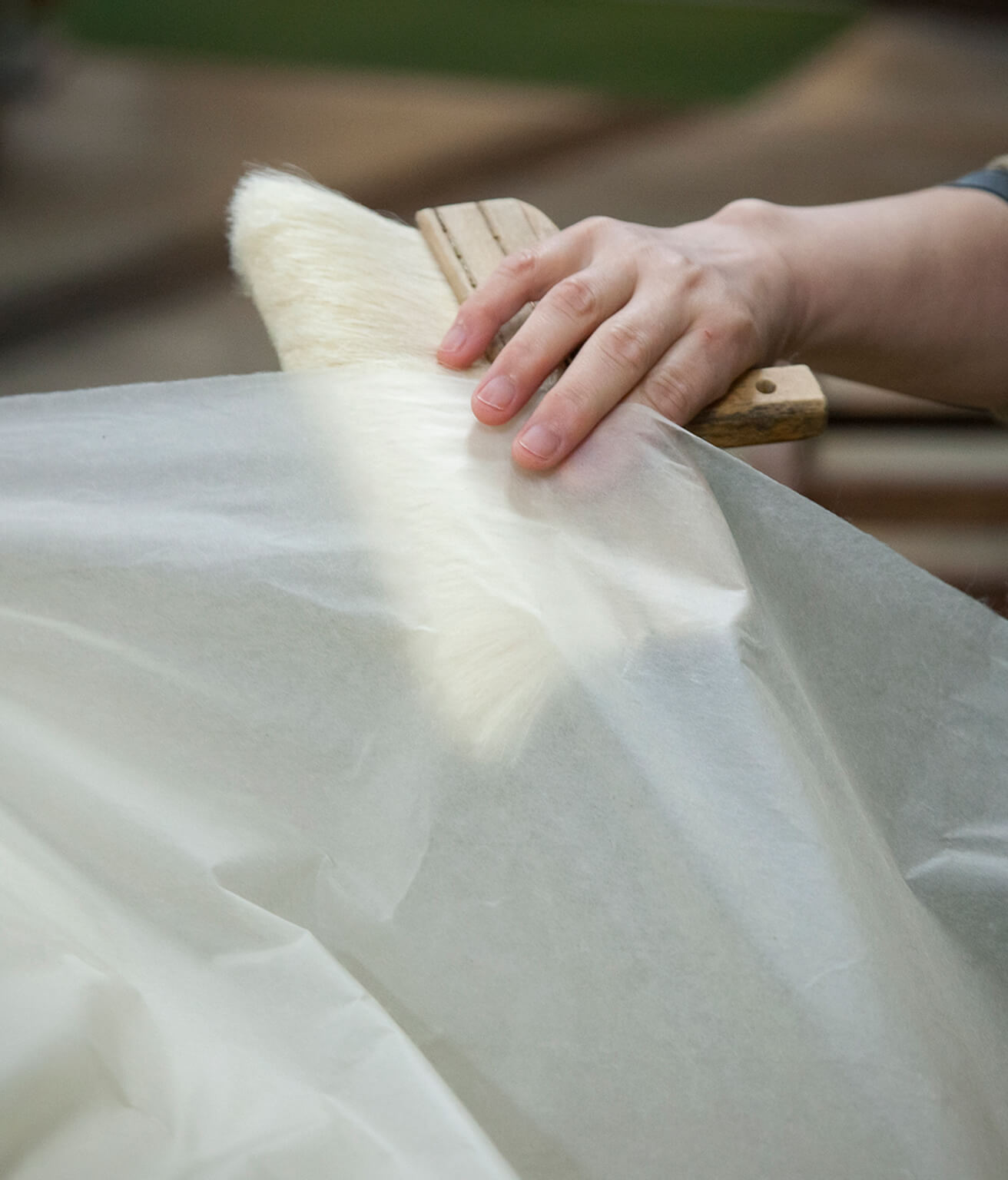Handcrafts developed under steep thatched roofs
Gokayama Washi no Sato Mr. Hideyuki Higashi

Gokayama washi—traditional Japanese handmade paper—is produced in a village that’s known for its traditional Japanese houses that have steep thatched roofs. The village is situated between Toyama Prefecture and Gifu Prefecture. It is said that, in the Edo period, the Gokayama washi tradition was carefully preserved by the Kaga Clan in order to make precious offerings.
“Up to the Showa thirties (1955-1964), every family made washi. Back then, all the houses here were traditional Japanese style, with steep thatched roofs. Inside traditional houses there was a lowered floor space, in which was their papermaking workshop.”
Mr. Higashi, the director of Gokayama Washi no Sato, looks back fondly on old times.
Whitening washi by using traditional techniques
The main raw material of Gokayama washi is Gokayama kozo—paper mulberry, which is still cultivated locally today. To whiten washi naturally, artisans place kozo on the snow. This traditional technique is called yukisarashi. They don’t use chemicals nor machines. Mr. Higashi believes in hand-crafting, and he has protected this tradition of Gokayama washi—whose color never fades and whose texture is always supple, even after 100 years.

“Gokayama washi started with shoji paper (shoji is a sliding translucent screen made of a latticework wooden frame covered with washi). We have always worked to improve the techniques for making white paper.”
Mr. Higashi is a traditional craftsman who has made washi for 30 years. He makes shoji paper and other washi goods (such as Hassunshi), which have been standardized since the Kaga Clan era.
“I use my handmade shoji paper at home. Light from the glass window is transformed into something else when it passes through shoji. The light transmitted through shoji warms our hearts.”
In recent years, our housing situation has changed, and now there are fewer Japanese-style rooms. Mr. Higashi feels sad that Japanese people have been losing the sensitivity and inspiration that our ancestors left through traditional Japanese architecture.
He would like people to see the charm of Gokayama washi. That is why washi glass (washi sandwiched between glass) is on display on the second floor of Washi no Sato.

Fearlessly taking on the challenge of creating a new brand
“Customers’ voices are always reflected in our new products. In my company there are 12 staff, including secretaries and sales assistants, but without listening to customers directly it’s hard for us to know what is needed in the market.”
They never give up practicing traditional techniques, but they are open and flexible regarding product development. From their openness and flexibility, three product lines were born: Aquwa, Chin Chiro, and FIVE.
In Aquwa, washi gift boxes are lined up alongside earrings with transparent acrylic resin inside which washi is wrapped. When the accessories are placed inside an elegant white washi box, they look like beautiful snow flowers in a snow festival. Acrylic and washi; they were confident enough to combine these incongruous materials, bowing to their customers’ tastes.
Chin Chiro products include book covers, card cases, and large and small boxes. All have a checked pattern in various vivid colors such as light blue, yellow-green, and pink.

“We might fail when we try something new, but customers’ voices are important,” says Mr. Higashi. He has put his efforts into the brand FIVE above all. Mr. Sen Ishimoto, who graduated from Musashino Art University, is in charge of this brand. He visited Gokayama with his friends in his final summer vacation from university. He loved the scenery there; it made him feel like he was in an old Japanese fairy tale. So he decided to move from Tokyo to Gokayama.
“FIVE was founded in collaboration with other designers,” says Mr. Ishimoto. “With this brand, we’re searching for the full potential of washi, trying to make it different from the traditional style.”
The main products in FIVE are cardcases, book covers, and so on. All are nicely designed and in beautiful colors. The FIVE products have a very distinctive style as compared to that of folk-traditional washi goods.


I asked Mr. Ishimoto to describe the charm of Gokayama washi. He replied immediately, “Its charm is the heartwarming space that it creates when light passes through it.”
Shoji paper is essential in the type of traditional Japanese house that has a steep thatched roof. I suppose that FIVE is also influenced by Mr. Higashi, who loves the warm light that comes though washi. The products from FIVE have such beautiful colors, and just looking at them is calming. Going forward, they are planning to create interior goods. Hopefully they will create more rooms with beautiful light.



Mr. Hideyuki Higashi
Born in Gokayama in 1956. Though his family made washi for a living, he moved to Toyama City, and chose to work for a company instead.
When he was 27 years old, he moved back home to make washi. Since the foundation of Gokayama Washi Craft Research Association, he worked there as a papermaking artisan.
Then later he was certified as a traditional craftsman. While promoting Gokayama washi, and training his successors, he dedicates himself to developing new washi products.
Gokayama Washi no Sato
- 215 Higashinakae, Nantoshi, Toyama, 939-1905 Japan
-
- Open
- 9:00 to 17:00 (Washi Workshop: until 16:30)
-
- Closed
- December 29th to January 3rd.
-
- TEL
- 0763-66-2223
-
- FAX
- 0763-66-2250
- http://gokayama-washinosato.com
